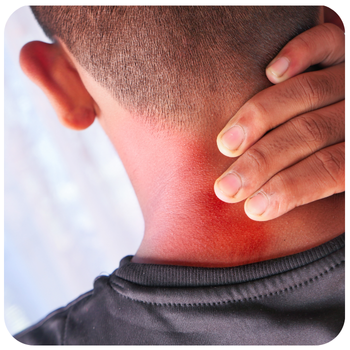Neck pain
Neck pain is common and often improves over time. It can usually be managed with simple self-care methods and staying active.
Common symptoms include:
- Dull or sharp pain that makes daily tasks difficult.
- Muscle spasms and stiffness.
- Limited neck movement.
- Occasionally, pain may spread to your arm, with sensations like burning, pins and needles, or numbness.
- Sometimes neck pain is linked to headaches.
Pain can come from muscles, joints, or nerves in the neck. While pinpointing the exact cause can be challenging, there are still effective ways to manage and alleviate symptoms.
Neck pain can sometimes spread to the arms, particularly if a nerve is irritated. Most of the time, following the same self-care advice will help, and the pain usually improves significantly within 12 weeks without special treatment.
Neck pain is very common and can happen for many reasons (although in some cases there is no obvious cause), but could include:
- Change in physical activity: If you suddenly start doing more or less physical activity than usual, for example working in an awkward position or being inactive for long periods of time at a computer
- Injuries: Getting hurt in a sporting accident or car collision
- Long-term issues: Sometimes other health issues like arthritis or fibromyalgia can ne involved
- Other factors: Things like being out of shape, feeling stressed, not sleeping well or in an uncomfortable position, or feeling depressed can also affect our physical health contributing to things like neck and back pain
Even though neck pain can be scary, it’s usually not dangerous and isn’t caused by getting older or poor posture.
For more information on neck pain, visit the Chartered Society of Physiotherapy website.
When your neck pain starts, it's a good idea to do less of what hurts, but you should also try to stay active.
Start moving again
Get back to being active slowly. You can do activities you enjoy, like walking, gardening, swimming, cycling, or yoga.
Feeling uncomfortable is normal
At first, moving might feel a bit uncomfortable, but that’s okay. Remember, feeling pain doesn’t always mean you’re hurting yourself. Your back is strong and made to move, so take it step by step.
Going back to work
If you’ve had to take time off work, talk to your workplace about returning. You might start with shorter hours or lighter tasks.
Medication
Sometimes speaking to your GP or Pharmacist about some simple pain relief can be very useful in the short term. However, Long term and regular use of pain medicines could cause harm, so remember - exercise works better.
Take care of your feelings
Feeling down, tired, or stressed can make your pain worse. Try to get good sleep and talk to friends or family for support.
Need more help?
Have a look at the links at the side of the page. You can also refer yourself to the MSK Together physiotherapy service.
Most neck pain isn’t serious, but sometimes there might be a bigger issue. If you have any of these symptoms, call your doctor, or call NHS 111.
- Persistent head, neck, or arm pain that affects your sleep
- Weakness or numbness in your arms or legs
- Feeling unwell, having a fever, or losing weight without explanation.
- History of serious trauma (like a car accident) or neck surgery
- New bladder issues with neck pain (like difficulty controlling your bladder)
- History of inflammatory arthritis, immune system problems, cancer, or tuberculosis (TB).
Scans, such as MRIs and X-rays, help to provide a picture of the spine. They can be used to help plan treatment or rule out serious conditions like cancer or a fracture. But scans can't show us how well our neck, nerves and muscles are functioning.
For these reasons, scans do not give a diagnosis. This is where an assessment with a health practitioner is more useful.
For most people (in fact 95% of people) with neck or back pain, scans are not needed and can cause more worry and anxiety which may negatively affect your recovery. We also know many of the changes seen on an MRI will often be seen in people without neck pain.
For more information about a spinal MRI and the results report, visit the NHS England website.
Below are some examples of early exercises designed to improve your mobility and function. They can be done several times a day, little and often.
Neck flexion
- Seated or standing, bend your neck forwards as far as is comfortable taking your chin towards your chest.
- You will feel a stretch at the back of your neck.
- Hold the position for three to five seconds.
- Repeat the above five to ten times.

Neck side flexion
- Seated or standing, tilt your head towards your shoulder as far as is comfortable
- You will feel a stretch on the opposite side
- Hold the position for three to five seconds
- Repeat the above five to ten times.

Neck rotation
- Seated or standing, turn your head to once side as far as is comfortable
- You will feel a stretch on the opposite side
- he position for three to five seconds
- Repeat the above five to ten times.

Chin tucks
- Seated or standing, tuck your chin backwards.
- Do not tilt your head downwards.
- You may feel a stretch at the back of your neck
- Hold for three to five seconds
- Repeat the above five to ten times.

Deep neck flexors
- Lying on your back with your knees bent, tuck your chin backwards
- Do not tilt your head forwards
- You may feel a stretch at the back of your neck
- Hold for three to five seconds
- Repeat the above five to ten times.

There are some similar exercises shown as a video below.
You can’t always prevent neck pain, just like you can’t always avoid catching a cold.
However, what’s really important for keeping your neck and body healthy is:
- Keeping moving (exploring movement with varied activity and avoiding being in one position for too long)
- Keeping a healthy weight
- Getting good sleep
- Managing stress
- Quitting smoking
- Drinking less alcohol
- Staying active
Being active helps you avoid long-term pain and serious health problems like diabetes, cancer, and heart disease. It also helps you live a longer, healthier life. Just like lifting weights makes your muscles strong, moving and exercising your back and neck makes it more resilient and healthier. Start slowly and keep practicing to safely regain the movement in your neck.
Getting help for better health
Get free local help from Your Health Notts website to:
- Improve your fitness
- Lose weight
- Stop smoking
- Reduce alcohol intake
- Help with exercise
If you need help with exercise, ask your doctor about the GP Exercise Referral Schemes. These offer discounted classes at local leisure centres:
Information in this section is intended to be used as a guide. It gives you an idea about how neck pain can be managed. However, you should remember that every case is different, and symptoms and management can vary from person to person.






